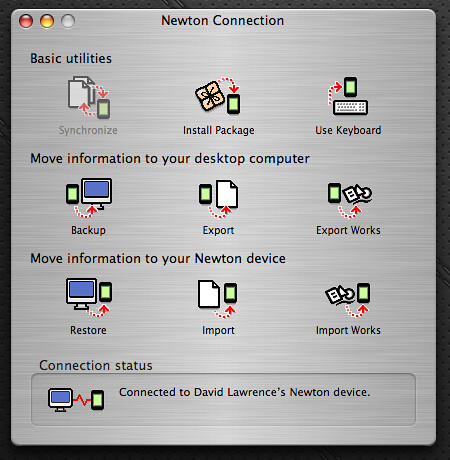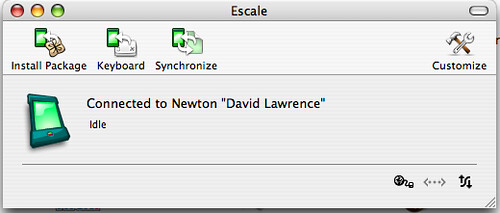
60 Minutes had an expose on electronic waste (e-waste) that really hit home. In his report, Scott Pelley found that a lot of American computers and electronics were being melted, burned, and stripped in China, releasing poisonous fumes and chemicals into the environment. Lead, dioxin, and chlorine-based compounds are finding their way into Chinese citizens’ bloostreams, and it’s mostly because of our computers, CRT monitors, and cell phones.
I’m on the board for a local recycling non-profit, and twice a year we hold e-waste drives for the community. It’s where I get a lot of my second-hand project Macs.
I’ve seen the amount of electronic junk that can pile up first hand. At our most recent e-waste drive, my organization collected 12 tons of electronics. Most of that was TVs and CRTs, which means a lot of people are switching to flat-screen TVs and LCD monitors. We work with a group from Grand Rapids, Michigan that strips the electronics at a local plant and sells off the scrap materials. They also sell any salvageable equipment. We’ve done the research, and visited their plant, just to make sure nothing is sent overseas, like 60 Minutes reported.
For me, this is a moral issue. What good is our comfortable existence if we’re poisoning another country and its people? Does the latest and greatest hardware make all that pollution justifiable? As Scott Pelley reported, it’s our planned-obsolescence society, our need to have the newest and fastest technology, that is to blame for the tons and tons of junk that gets sent overseas. Our lifestyle is a card trick: we’re just shuffling the burden of our materialism to poorer, less-well-off citizens.
As a classic Mac appreciator and user, I take part of the responsibility for easing China’s burden. Rescuing Macs from the trash heap is a hobby for me. Besides all the fun I have with these “obsolete” machines, in a way I’m saving them from being stripped, buried, or burned. Luckily the recycler we deal with is dedicated to keeping e-waste out of third-world countries. But my small effort saves the energy and resources it takes to either (a) recycle the computers or (b) create new ones. I haven’t bought a brand-new Mac since 2005; my iMac G4 works just fine, thanks.
I’m certainly not alone. There’s a giant community of low end Mac users (with a web site to boot) out there who save these classic computers from the e-scrap pile. For them, old Macs are usable (and mod-able!) Macs. Some even prefer the older machines and their quirky personalities. Maybe the strongest exhibit requires only a quick glance at the Newton user community .
Here’s something to think about: Apple’s laser-precise focus on environmental responsibility is a great thing. I salute it. Now think about all those Mac SEs and Performas out there that don’t receive the benefits of PVC- and mercury-free construction. Tossing a Color Classic in a dumpster is like carpet-bombing some poor village in Africa. Older Macs are filled with pollutants – as are older PCs, TVs, and electronics.
It’s comforting to know that Macs have a long, long after-market life on eBay and Craiglist. Name another computer manufacturer that can claim the kind prices a used Mac can fetch on an auction site.
Macs are also built to last. Macs from the G4 and G5 era, while just now starting to show their age, can get plenty of use (and a fair auction price) for years to come. My own Bondi Blue iMac is still chugging along 10 years later, and we hear plenty of stories about Mac SEs getting tons of use in our gigahertz age. As Apple appreciators, we can sleep a little easier at night knowing our corner of the computing world causes less harm than, say, all those business Dells that get tossed from year to year.
But we’re not innocent. Not by a long shot. No matter how many Macs I rescue from our e-waste drives, there are tons – all across America – that get trashed every single day. My heart breaks every time I see a smashed iMac G3 or an old Apple II that someone drops off to be recycled. That just means one more kid in China might end up with some crippling disease.
Corny? A little. Maybe what we ought to be doing instead is giving our Macs a good home. I bet that kid in China would love a slightly-used iBook so that he or she could learn about computers. Instead of One Laptop Per Child, we could initiate a One Used Mac Per Child. It would require rounding up thousands of usable Macs, installing OS 9 or OS X and some basic apps, and making minor upgrades where possible. We’re all Apple nerds: the project would keep us busy for months. But, man, think of how much fun we’d have. And we would have some small impact on the problem of e-waste.
We could team up with electronic recyclers across America and give them the message: give us your broken, your used, your beat-up Macs. We’ll take them home, fix them up, and give them to kids to don’t otherwise have the means or the ability to purchase a computer. There are groups out there that do this kind of thing, but ours would be special. Ours involves Macs. What kid would smile, knowing he or she would be getting a fix-up, usable, Internet-ready Macintosh? There are risks of course, and unintended consequences to consider. But with OUMPC, the benefits are two-fold: more Macs in deserving hands, and less e-waste.
How many of us have extra power cords, OS discs, keyboards, mice, and Ethernet connectors? How many of us have a perfectly fuctional Mac sitting in the closet? How many of us have the credentials to get a simple web site and application process up and running in a matter of days? You think the number of Mac users is growing by leaps and bounds now? Imagine that number when every kid who needs one gets a freshened-up Mac in the family room.
Just imagine.
In the meantime, now that Apple is taking more responsibility for its environmental impact, the Macs made from here on out will be less detrimental to our planet. So there’s hope. But the damage is being done, and from the amount of e-junk we receive at our modest community e-waste drives, there are tons and tons of materials out there that aren’t accounted for. It’s frightening.
All we can do is use our Macs longer, hand down our used Macs to those who can appreciate them, and make sure our throwaways are recycled in an environmentally-friendly manner.
Given the damage we’ve already done, it’s the least we can do.
[Image courtesy of Greenpeace.]





